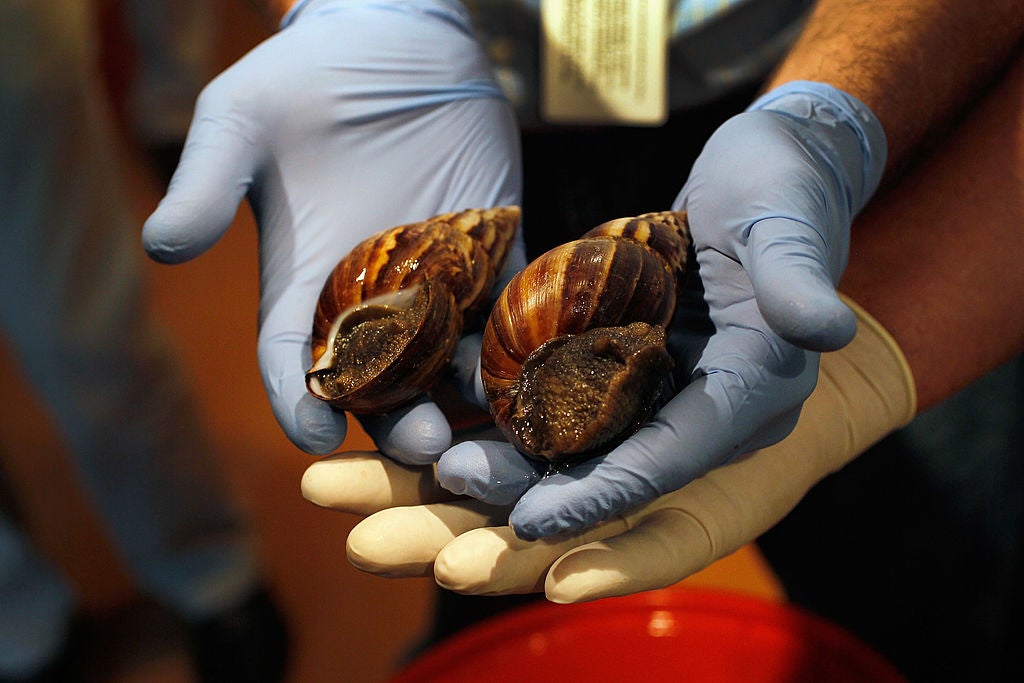The giant African land snails invading Florida threatening disease and economic disaster
Pests can grow to eight inches long, live for over a decade, reproduce rapidly and even chew through stucco, paint and plastic recycling bins

An invading horde of giant African land snails has forced a county in southern Florida to introduce a quarantine zone in the hope of stopping the marauding molluscs before they can lay waste to the local environment.
A 3.5 square mile region of Broward County is being staked out to try to stall the advance of the pests after they were spotted in the Miramar area earlier this month, with the Florida Department of Agriculture and Consumer Services (FDACS) warning on Tuesday: “These snails could be devastating to Florida agriculture and natural areas as they cause extensive damage to tropical and subtropical environments.”
The order makes it illegal for residents to move in or out of the area – without a compliance agreement – any snails they might encounter or any regulated article such as plants, soil, compost, yard waste or building materials in which the creatures might reside.
Local officials will meanwhile attempt to eradicate the snails by treating their likely haunts with a metaldehyde-based molluscicide, a form of bait approved by the US Environmental Protection Agency for residential use.
The species has been described by the FDACS as “one of the most damaging snails in the world” and can grow to eight inches long and weigh 2.2 pounds, identifiable by both its size and striped brown shell.
These slithering brutes consume more than 500 kinds of plantlife, including peanuts, beans and melons – meaning they pose a significant economic threat to the region’s $8bn-a-year agricultural sector – live for over a decade, reproduce rapidly and chew through stucco, paint and even plastic recycling bins.
As if that were not sufficiently alarming, their calcium shells carry points sharp enough to burst a car tire and they also pose a health risk to humans by harbouring a nasty-sounding parasite known as rat lungworm, which can cause meningitis and induce swelling of the membranes surrounding the brain and spinal cord.
Although they are attracted to Florida’s balmy heat and subtropical ecosystems, the snails are, as the name suggests, native to Africa and were only introduced to the Sunshine State in the 1960s, causing havoc to local crops and taking a decade to remove at a cost of $1m.
They were subsequently made illegal to import or possess as pets in the United States without a permit but have nevertheless returned to Florida within the last decade, perhaps the fault of a religious leader who was investigated in March 2010 for smuggling them into the state so that his followers could heal themselves by drinking the creatures’ mucus in accordance with the traditions of his El Africano faith.

That outbreak saw Florida commence a second eradication campaign involving sniffer dogs being deployed and an emergency hotline set up for residents to report sightings before Broward and Miami-Dade counties finally declared victory in October 2021, announcing the removal of 160,000 snails in total.
Those celebrations proved premature, however, as, before their most recent re-emergence in Broward County, parts of both Lee County and Pasco County reported reinfestations last spring and summer.
Long before laying siege to Florida, the snails were first introduced into Hawaii in 1936, where university research professor Robert Cowie continues to study their biology.
“They’re potentially dangerous from the disease perspective,” Professor Cowie told The Washington Post, adding that they are also “an enormous nuisance in terms of eating all your plants in your yard, climbing up the walls of your house, pooping everywhere. They just make a mess.”
He urged Floridians living in the affected area not to touch the snails with their bare hands or eat them and to prevent their children and pets from doing likewise.
Join our commenting forum
Join thought-provoking conversations, follow other Independent readers and see their replies
Comments


Bookmark popover
Removed from bookmarks